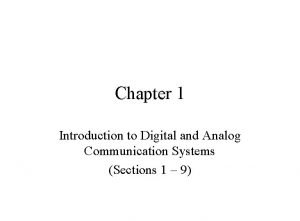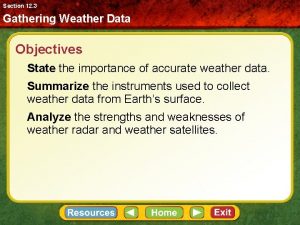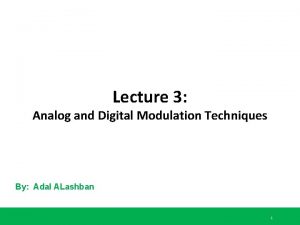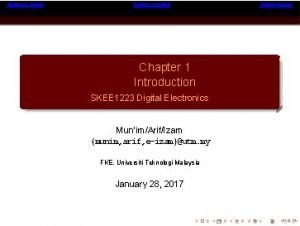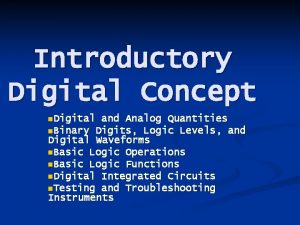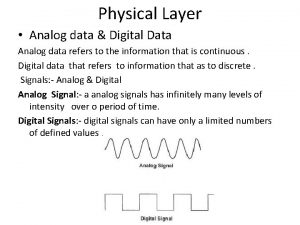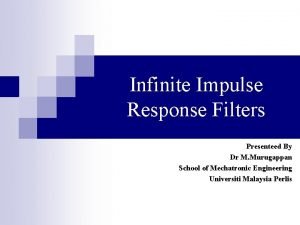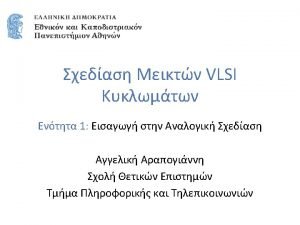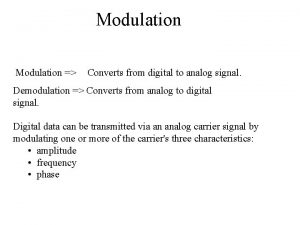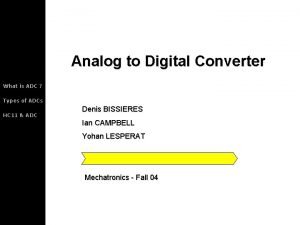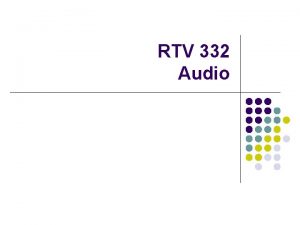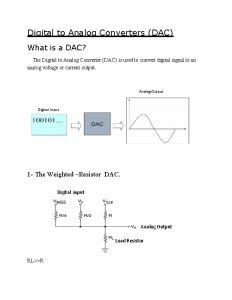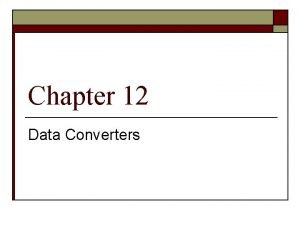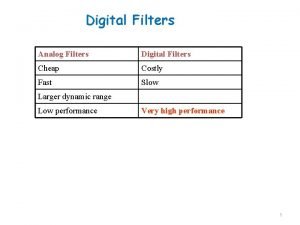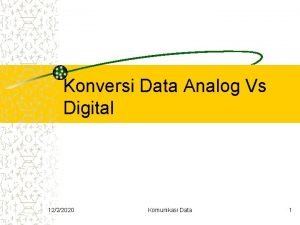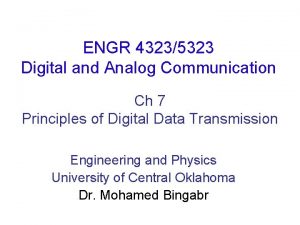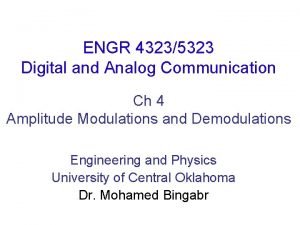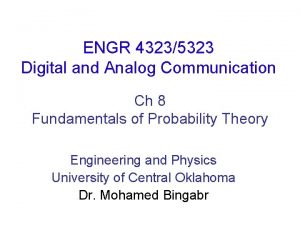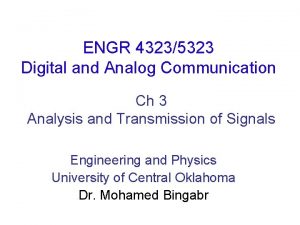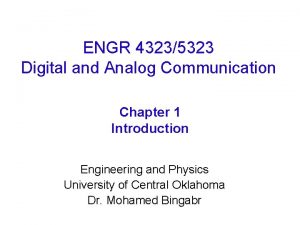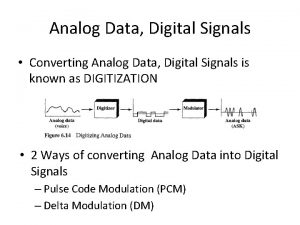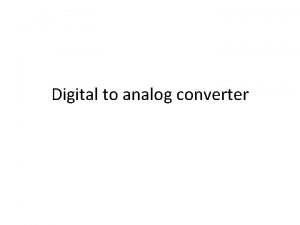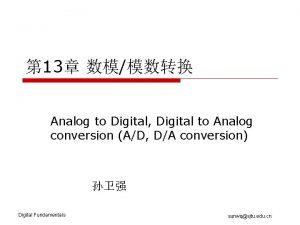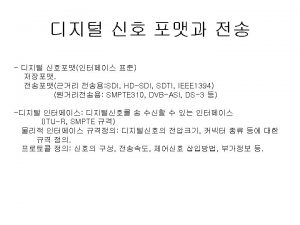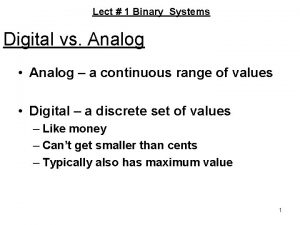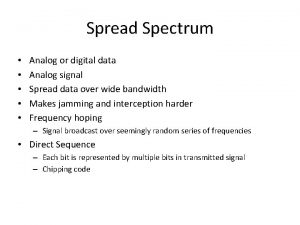ENGR 43235323 Digital and Analog Communication Ch 2

































- Slides: 33

ENGR 4323/5323 Digital and Analog Communication Ch 2 Signals and Signal Space Engineering and Physics University of Central Oklahoma Dr. Mohamed Bingabr

Outline • • Size of a Signal Classification of Signals Useful Signals and Signal Operations Signals Versus Vectors Correlation of Signals Orthogonal Signal Sets Trigonometric and Exponential Fourier Series

Signal Energy and Power Energy Signal Power Signal Energy Power

Signal Classification 1. Continuous-time and discrete-time signals 2. Analog and digital signals 3. Periodic and aperiodic signals 4. Energy and power signals 5. Deterministic and probabilistic signals 6. Causal and non-causal 7. Even and Odd signals

Analog continuous Digital continuous Analog Discrete Digital Discrete Periodic Deterministic Aperiodic Probabilistic

Useful Signal Operation Time Shifting Time Scaling Time Inversion x(t) 2 1 -1 1 t

Useful Signals Unit impulse Signal Unit step function u(t)

Signals Versus Vectors By sampling, a continuous signal g(t) can be represented as vector g. g = [ g(t 1) g(t 2) … g(tn)] Vector Approximation To approximate vector g using another vector x then we need to choose c that will minimize the error e. g = cx + e Note: Dot product: <g, x> = ||g||. ||x|| cos θ

Signals Versus Vectors Value of c that minimizes the error Signal Approximation g(t) = cx(t) + e(t) x(t)

Correlation of Signals Two vectors are similar if the angle between them is small. Correlation coefficient Note: Similarity between vectors or signals does not depend on the length of the vectors or the strength of the signals.

Example Which of the signals g 1(t), g 2(t), …, g 6(t) are similar to x(t)? 1=1 2=1 3=-1 4=0. 961 5=0. 628 6=0

Cross-Correlation Function 4 g(t- )

Autocorrelation Function g(t) g(t- )

Orthogonal Signal Sets Orthogonal Vector Space g = c 1 x 1 + c 2 x 2 + c 3 x 3 Orthogonal Signal Space g(t) = c 1 x 1(t)+ c 2 x 2(t) + … + c. Nx. N(t) Parseval’s Theorem

Trigonometric Fourier Series

Example f(t) 1 e-t/2 -p 0 p • Fundamental period T 0 = p • Fundamental frequency f 0 = 1/T 0 = 1/p Hz w 0 = 2 p/T 0 = 2 rad/s To what value does the FS converge at the point of discontinuity?

Compact Trigonometric Fourier Series We can use the trigonometric identity a cos(x) + b sin(x) = c cos(x + ) to find the compact trigonometric Fourier series dc component nth harmonics C 0, Cn, and θn are related to the trigonometric coefficients an and bn as:

Role of Amplitude in Shaping Waveform

Role of the Phase in Shaping a Periodic Signal

Compact Trigonometric f(t) 1 e-t/2 -p 0 p • Fundamental period T 0 = p • Fundamental frequency f 0 = 1/T 0 = 1/p Hz w 0 = 2 p/T 0 = 2 rad/s

Line Spectra of x(t) • The amplitude spectrum of x(t) is defined as the plot of the magnitudes |Cn| versus • The phase spectrum of x(t) is defined as the plot of the angles versus • This results in line spectra • Bandwidth the difference between the highest and lowest frequencies of the spectral components of a signal.

Line Spectra f(t) 1 e-t/2 -p p 0 f(t)=0. 504 + 0. 244 cos(2 t-75. 96 o) + 0. 125 cos(4 t-82. 87 o) + 0. 063 cos(8 t-86. 24 o) + … 0. 084 cos(6 t-85. 24 C n n 0. 504 0. 244 0. 125 0 2 4 0. 084 6 0. 063 8 10 - /2

Exponential Fourier Series To find Dn multiply both side by over a full period, m =1, 2, …, n, … and then integrate Dn is a complex quantity in general Dn=|Dn|ej D-n = Dn* |Dn|=|D-n| Even Dn = - D-n Odd D 0 is called the constant or dc component of x(t)

Line Spectra in the Exponential Form • The line spectra for the exponential form has negative frequencies because of the mathematical nature of the complex exponent. D 0= C 0 Cn = 2 |Dn| Dn = n 0 D-n = - Cn Cn

Example Find the exponential Fourier Series for the squaref(t) pulse periodic signal. 1 -2 p -p -p/2 p 2 p • Fundamental period T 0 = 2 p • Fundamental frequency f 0 = 1/T 0 = 1/2 p Hz w 0 = 2 p/T 0 = 1 rad/s

Exponential Line Spectra |Dn| 1 1 Dn 1 1

Example The compact trigonometric Fourier Series coefficients for the square-pulse periodic signal. f(t) 1 -2 p -p -p/2 p 2 p • Fundamental frequency f 0 = 1/T 0 = 1/2 p Hz w 0 = 2 p/T 0 = 1 rad/s

Relationships between the Coefficients of the Different Forms

Example Find the exponential Fourier Series and sketch the corresponding spectra for the impulse train shown below. From this result sketch the trigonometric spectrum and write the trigonometric Fourier Series. Solution -2 T 0 -T 0 2 T 0

Dirichlet Conditions for FS Convergence

Parseval’s Theorem • Let x(t) be a periodic signal with period T • The average power P of the signal is defined as • Expressing the signal as it is also

Numerical Calculation of Fourier Series

Matlab Exercise Page 80 g(t) 1 T 0 = pi; e N 0 = 256; 0 Ts = T 0/N 0; -p p t = 0: Ts*(N 0 -1); T 0 = p g = exp(-t/2); f 0 = 1/T 0 = 1/p Hz g(1) = 0. 604; w 0 = 2 p/T 0 = 2 rad/s Dn = fft(g)/N 0; [Dnangle, Dnmag] = cart 2 pol( real(Dn), imag(Dn)); k =0: length(Dn)-1; k = 2*k; subplot(211), stem(k, Dnmag) subplot(212), stem(k, Dnangle) -t/2
 Analog vs digital communication systems
Analog vs digital communication systems Digital to analog conversion in data communication
Digital to analog conversion in data communication Compare and contrast weather
Compare and contrast weather Compare and contrast analog and digital forecasting
Compare and contrast analog and digital forecasting Disadvantages of fsk
Disadvantages of fsk Introduction to digital video
Introduction to digital video Difference between analog and digital editing
Difference between analog and digital editing Analog and digital transmission
Analog and digital transmission Analog image and digital image
Analog image and digital image Analogue and digital transmission in computer networks
Analogue and digital transmission in computer networks Analog vs digital chips
Analog vs digital chips Digital and analog quantities
Digital and analog quantities Advantages of digital computers
Advantages of digital computers Analog vs digital video
Analog vs digital video Analog signla
Analog signla Impulse invariant method formula
Impulse invariant method formula Introduction to digital control
Introduction to digital control Razavi cmos analog circuit design
Razavi cmos analog circuit design Pengertian teknologi digital
Pengertian teknologi digital Analog vs digital
Analog vs digital Modulation digital to analog
Modulation digital to analog Amw huebsch
Amw huebsch Advantages and disadvantages of flash adc
Advantages and disadvantages of flash adc Single slope adc
Single slope adc Rumus adc
Rumus adc Rumus adc
Rumus adc Rtv 332
Rtv 332 Digital signal as a composite analog signal
Digital signal as a composite analog signal Sebutkan 2 kelemahan modulasi digital
Sebutkan 2 kelemahan modulasi digital Digital to analog converter
Digital to analog converter Digital to analog converters basic concepts
Digital to analog converters basic concepts Digital to analog encoding
Digital to analog encoding Filter lpf hpf bpf brf
Filter lpf hpf bpf brf Analog vs digital
Analog vs digital
